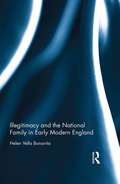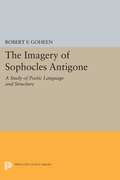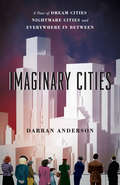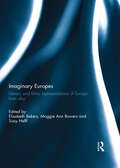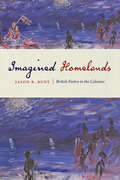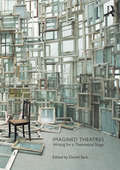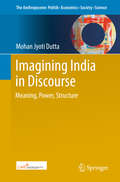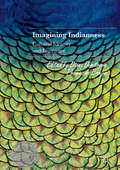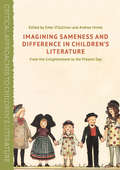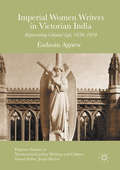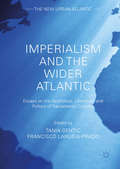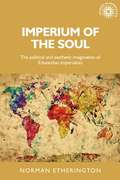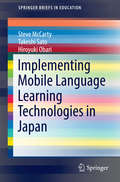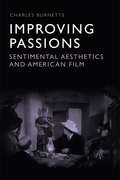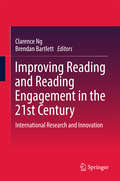- Table View
- List View
Illegitimacy and the National Family in Early Modern England
by Helen Vella BonavitaThis study considers the figure of the bastard in the context of analogies of the family and the state in early modern England. The trope of illegitimacy, more than being simply a narrative or character-driven issue, is a vital component in the evolving construction and representation of British national identity in prose and drama of the sixteenth and early seventeenth century. Through close reading of a range of plays and prose texts, the book offers readers new insight into the semiotics of bastardy and concepts of national identity in early modern England, and reflects on contemporary issues of citizenship and identity. The author examines play texts of the period including Bale's King Johan, Peele's The Troublesome Reign of John, and Shakespeare's King John, Richard II, and King Lear in the context of a selection of legal, religious, and polemical texts. In so doing, she illuminates the extent to which the figure of the bastard and, more generally the trope of illegitimacy, existed as a distinct discourse within the wider discursive framework of family and nation.
Imagery of Sophocles Antigone
by Robert Francis GoheenA systematic investigation of a Greek text, employing the techniques of the "new criticism." The book is a major contribution to the study of Sophocles and of Greek drama.Originally published in 1951.The Princeton Legacy Library uses the latest print-on-demand technology to again make available previously out-of-print books from the distinguished backlist of Princeton University Press. These editions preserve the original texts of these important books while presenting them in durable paperback and hardcover editions. The goal of the Princeton Legacy Library is to vastly increase access to the rich scholarly heritage found in the thousands of books published by Princeton University Press since its founding in 1905.
Imaginary Cities: A Tour of Dream Cities, Nightmare Cities, and Everywhere in Between
by Darran AndersonFor as long as humans have gathered in cities, those cities have had their shining—or shadowy—counterparts. Imaginary cities, potential cities, future cities, perfect cities. It is as if the city itself, its inescapable gritty reality and elbow-to-elbow nature, demands we call into being some alternative, yearned-for better place. This book is about those cities. It’s neither a history of grand plans nor a literary exploration of the utopian impulse, but rather something different, hybrid, idiosyncratic. It’s a magpie’s book, full of characters and incidents and ideas drawn from cities real and imagined around the globe and throughout history. Thomas More’s allegorical island shares space with Soviet mega-planning; Marco Polo links up with James Joyce’s meticulously imagined Dublin; the medieval land of Cockaigne meets the hopeful future of Star Trek. With Darran Anderson as our guide, we find common themes and recurring dreams, tied to the seemingly ineluctable problems of our actual cities, of poverty and exclusion and waste and destruction. And that’s where Imaginary Cities becomes more than a mere—if ecstatically entertaining—intellectual exercise: for, as Anderson says, “If a city can be imagined into being, it can be re-imagined.” Every architect, philosopher, artist, writer, planner, or citizen who dreams up an imaginary city offers lessons for our real ones; harnessing those flights of hopeful fancy can help us improve the streets where we live. Though it shares DNA with books as disparate as Calvino’s Invisible Cities and Jane Jacobs’s Death and Life of Great American Cities, there’s no other book quite like Imaginary Cities. After reading it, you’ll walk the streets of your city—real or imagined—with fresh eyes.
Imaginary Cities: A Tour of Dream Cities, Nightmare Cities, and Everywhere in Between
by Darran AndersonFor as long as humans have gathered in cities, those cities have had their shining—or shadowy—counterparts. Imaginary cities, potential cities, future cities, perfect cities. It is as if the city itself, its inescapable gritty reality and elbow-to-elbow nature, demands we call into being some alternative, yearned-for better place. This book is about those cities. It’s neither a history of grand plans nor a literary exploration of the utopian impulse, but rather something different, hybrid, idiosyncratic. It’s a magpie’s book, full of characters and incidents and ideas drawn from cities real and imagined around the globe and throughout history. Thomas More’s allegorical island shares space with Soviet mega-planning; Marco Polo links up with James Joyce’s meticulously imagined Dublin; the medieval land of Cockaigne meets the hopeful future of Star Trek. With Darran Anderson as our guide, we find common themes and recurring dreams, tied to the seemingly ineluctable problems of our actual cities, of poverty and exclusion and waste and destruction. And that’s where Imaginary Cities becomes more than a mere—if ecstatically entertaining—intellectual exercise: for, as Anderson says, “If a city can be imagined into being, it can be re-imagined.” Every architect, philosopher, artist, writer, planner, or citizen who dreams up an imaginary city offers lessons for our real ones; harnessing those flights of hopeful fancy can help us improve the streets where we live. Though it shares DNA with books as disparate as Calvino’s Invisible Cities and Jane Jacobs’s Death and Life of Great American Cities, there’s no other book quite like Imaginary Cities. After reading it, you’ll walk the streets of your city—real or imagined—with fresh eyes.
Imaginary Cities: A Tour of Dream Cities, Nightmare Cities, and Everywhere in Between
by Darran AndersonFor as long as humans have gathered in cities, those cities have had their shining—or shadowy—counterparts. Imaginary cities, potential cities, future cities, perfect cities. It is as if the city itself, its inescapable gritty reality and elbow-to-elbow nature, demands we call into being some alternative, yearned-for better place. This book is about those cities. It’s neither a history of grand plans nor a literary exploration of the utopian impulse, but rather something different, hybrid, idiosyncratic. It’s a magpie’s book, full of characters and incidents and ideas drawn from cities real and imagined around the globe and throughout history. Thomas More’s allegorical island shares space with Soviet mega-planning; Marco Polo links up with James Joyce’s meticulously imagined Dublin; the medieval land of Cockaigne meets the hopeful future of Star Trek. With Darran Anderson as our guide, we find common themes and recurring dreams, tied to the seemingly ineluctable problems of our actual cities, of poverty and exclusion and waste and destruction. And that’s where Imaginary Cities becomes more than a mere—if ecstatically entertaining—intellectual exercise: for, as Anderson says, “If a city can be imagined into being, it can be re-imagined.” Every architect, philosopher, artist, writer, planner, or citizen who dreams up an imaginary city offers lessons for our real ones; harnessing those flights of hopeful fancy can help us improve the streets where we live. Though it shares DNA with books as disparate as Calvino’s Invisible Cities and Jane Jacobs’s Death and Life of Great American Cities, there’s no other book quite like Imaginary Cities. After reading it, you’ll walk the streets of your city—real or imagined—with fresh eyes.
Imaginary Cities: A Tour of Dream Cities, Nightmare Cities, and Everywhere in Between
by Darran AndersonFor as long as humans have gathered in cities, those cities have had their shining—or shadowy—counterparts. Imaginary cities, potential cities, future cities, perfect cities. It is as if the city itself, its inescapable gritty reality and elbow-to-elbow nature, demands we call into being some alternative, yearned-for better place. This book is about those cities. It’s neither a history of grand plans nor a literary exploration of the utopian impulse, but rather something different, hybrid, idiosyncratic. It’s a magpie’s book, full of characters and incidents and ideas drawn from cities real and imagined around the globe and throughout history. Thomas More’s allegorical island shares space with Soviet mega-planning; Marco Polo links up with James Joyce’s meticulously imagined Dublin; the medieval land of Cockaigne meets the hopeful future of Star Trek. With Darran Anderson as our guide, we find common themes and recurring dreams, tied to the seemingly ineluctable problems of our actual cities, of poverty and exclusion and waste and destruction. And that’s where Imaginary Cities becomes more than a mere—if ecstatically entertaining—intellectual exercise: for, as Anderson says, “If a city can be imagined into being, it can be re-imagined.” Every architect, philosopher, artist, writer, planner, or citizen who dreams up an imaginary city offers lessons for our real ones; harnessing those flights of hopeful fancy can help us improve the streets where we live. Though it shares DNA with books as disparate as Calvino’s Invisible Cities and Jane Jacobs’s Death and Life of Great American Cities, there’s no other book quite like Imaginary Cities. After reading it, you’ll walk the streets of your city—real or imagined—with fresh eyes.
Imaginary Europes: Literary and filmic representations of Europe from afar
by Elisabeth Bekers Maggie Ann Bowers Sissy HelffThe 20th century has witnessed crucial changes in our perceptions of Europe. Two World Wars and many regional conflicts, the end of empires and of the Eastern Bloc, the creation and expansion of the European Union, and the continuous reshaping of Europe’s population through emigration, immigration, and globalization have led to a proliferation of images of Europe within the continent and beyond. While Eurocentrism governs current public debates in Europe, this book takes a special interest in literary and cinematographic imaginings of Europe that are produced from more distant, decentred, or peripheral vantage points and across differences of political power, ideological or ethnic affinity, cultural currency, linguistic practice, and geographical location. The contributions to this book demonstrate how these particular imaginings of Europe, often without first-hand experience of the continent, do not simply hold up a mirror to Europe, but dare to conceive of new perspectives and constellations for Europe that call for a shifting of critical positions. In so doing, the artistic visions from afar confirm the significance of cultural imagination in (re)conceptualizing the past, present, and future of Europe. This book was originally published as a special issue of the Journal of Postcolonial Writing.
Imaginary Europes: Literary and filmic representations of Europe from afar
by Elisabeth Bekers, Maggie Ann Bowers and Sissy HelffThe 20th century has witnessed crucial changes in our perceptions of Europe. Two World Wars and many regional conflicts, the end of empires and of the Eastern Bloc, the creation and expansion of the European Union, and the continuous reshaping of Europe’s population through emigration, immigration, and globalization have led to a proliferation of images of Europe within the continent and beyond. While Eurocentrism governs current public debates in Europe, this book takes a special interest in literary and cinematographic imaginings of Europe that are produced from more distant, decentred, or peripheral vantage points and across differences of political power, ideological or ethnic affinity, cultural currency, linguistic practice, and geographical location. The contributions to this book demonstrate how these particular imaginings of Europe, often without first-hand experience of the continent, do not simply hold up a mirror to Europe, but dare to conceive of new perspectives and constellations for Europe that call for a shifting of critical positions. In so doing, the artistic visions from afar confirm the significance of cultural imagination in (re)conceptualizing the past, present, and future of Europe. This book was originally published as a special issue of the Journal of Postcolonial Writing.
Imagined Homelands: British Poetry in the Colonies
by Jason R. RudyImagined Homelands chronicles the emerging cultures of nineteenth-century British settler colonialism, focusing on poetry as a genre especially equipped to reflect colonial experience. Jason Rudy argues that the poetry of Victorian-era Australia, New Zealand, South Africa, and Canada;¢;‚¬;€?often disparaged as derivative and uncouth;¢;‚¬;€?should instead be seen as vitally engaged in the social and political work of settlement. The book illuminates cultural pressures that accompanied the unprecedented growth of British emigration across the nineteenth century. It also explores the role of poetry as a mediator between familiar British ideals and new colonial paradigms within emerging literary markets from Sydney and Melbourne to Cape Town and Halifax. Rudy focuses on the work of poets both canonical;¢;‚¬;€?including Tennyson, Browning, Longfellow, and Hemans;¢;‚¬;€?and relatively obscure, from Adam Lindsay Gordon, Susanna Moodie, and Thomas Pringle to Henry Kendall and Alexander McLachlan. He examines in particular the nostalgic relations between home and abroad, core and periphery, whereby British emigrants used both original compositions and canonical British works to imagine connections between their colonial experiences and the lives they left behind in Europe.Drawing on archival work from four continents, Imagined Homelands insists on a wider geographic frame for nineteenth-century British literature. From lyrics printed in newspapers aboard emigrant ships heading to Australia and South Africa, to ballads circulating in New Zealand and Canadian colonial journals, poetry was a vibrant component of emigrant life. In tracing the histories of these poems and the poets who wrote them, this book provides an alternate account of nineteenth-century British poetry and, more broadly, of settler colonial culture.
Imagined Homelands: British Poetry in the Colonies
by Jason R. RudyImagined Homelands chronicles the emerging cultures of nineteenth-century British settler colonialism, focusing on poetry as a genre especially equipped to reflect colonial experience. Jason Rudy argues that the poetry of Victorian-era Australia, New Zealand, South Africa, and Canada;¢;‚¬;€?often disparaged as derivative and uncouth;¢;‚¬;€?should instead be seen as vitally engaged in the social and political work of settlement. The book illuminates cultural pressures that accompanied the unprecedented growth of British emigration across the nineteenth century. It also explores the role of poetry as a mediator between familiar British ideals and new colonial paradigms within emerging literary markets from Sydney and Melbourne to Cape Town and Halifax. Rudy focuses on the work of poets both canonical;¢;‚¬;€?including Tennyson, Browning, Longfellow, and Hemans;¢;‚¬;€?and relatively obscure, from Adam Lindsay Gordon, Susanna Moodie, and Thomas Pringle to Henry Kendall and Alexander McLachlan. He examines in particular the nostalgic relations between home and abroad, core and periphery, whereby British emigrants used both original compositions and canonical British works to imagine connections between their colonial experiences and the lives they left behind in Europe.Drawing on archival work from four continents, Imagined Homelands insists on a wider geographic frame for nineteenth-century British literature. From lyrics printed in newspapers aboard emigrant ships heading to Australia and South Africa, to ballads circulating in New Zealand and Canadian colonial journals, poetry was a vibrant component of emigrant life. In tracing the histories of these poems and the poets who wrote them, this book provides an alternate account of nineteenth-century British poetry and, more broadly, of settler colonial culture.
Imagined Theatres: Writing for a Theoretical Stage
by Daniel SackImagined Theatres collects theoretical dramas written by some of the leading scholars and artists of the contemporary stage. These dialogues, prose poems, and microfictions describe imaginary performance events that explore what might be possible and impossible in the theatre. Each scenario is mirrored by a brief accompanying reflection, asking what they might mean for our thinking about the theatre. These many possible worlds circle around questions that include: In what way is writing itself a performance? How do we understand the relationship between real performances that engender imaginary reflections and imaginary conceptions that form the basis for real theatrical productions? Are we not always imagining theatres when we read or even when we sit in the theatre, watching whatever event we imagine we are seeing?
Imagined Theatres: Writing for a Theoretical Stage
by Daniel SackImagined Theatres collects theoretical dramas written by some of the leading scholars and artists of the contemporary stage. These dialogues, prose poems, and microfictions describe imaginary performance events that explore what might be possible and impossible in the theatre. Each scenario is mirrored by a brief accompanying reflection, asking what they might mean for our thinking about the theatre. These many possible worlds circle around questions that include: In what way is writing itself a performance? How do we understand the relationship between real performances that engender imaginary reflections and imaginary conceptions that form the basis for real theatrical productions? Are we not always imagining theatres when we read or even when we sit in the theatre, watching whatever event we imagine we are seeing?
Imagining India in Discourse: Meaning, Power, Structure (The Anthropocene: Politik—Economics—Society—Science #14)
by Mohan Jyoti DuttaThe economic liberalization of India, changes in global structures, and the rapid emergence of India on the global landscape have been accompanied by the dramatic rise in popular, public, and elite discourses that offer the promise to imagine India. Written mostly in the future tense, these discourses conceive of India through specific frames of global change and simultaneously offer prescriptive suggestions for the pathways to fulfilling the vision. Both as summary accounts of the shifts taking place in India and in the relationships of India with other global actors as well as roadmaps for the immediate and longer term directions for India, these discourses offer meaningful entry points into elite imaginations of India. Engaging these imaginations creates a framework for understanding the tropes that are mobilized in support of specific policy formulations in economic, political, cultural, and social spheres. Connecting meanings within networks of power and structure help make sense of the symbolic articulations of India within material relationships.
Imagining Indianness: Cultural Identity and Literature
by Diana Dimitrova Thomas De BruijnThis book brings together several important essays examining the interface between identity, culture, and literature within the issue of cultural identity in South Asian literature. The book explores how one imagines national identity and how this concept is revealed in the narratives of the nation and the production of various cultural discourses. The collection of essays examines questions related to the interpretation of the Indian past and present, the meanings of ancient and venerated cultural symbols in ancient times and modern, while discussing the ideological implications of the interpretation of identity and “Indianness” and how they reflect and influence the power-structures of contemporary societies in South Asia. Thus, the book studies the various aspects of the on-going process of constructing, imagining, re-imagining, and narrating “Indianness”, as revealed in the literatures and cultures of India.
Imagining Indianness: Cultural Identity and Literature
by Diana Dimitrova Thomas De BruijnThis book brings together several important essays examining the interface between identity, culture, and literature within the issue of cultural identity in South Asian literature. The book explores how one imagines national identity and how this concept is revealed in the narratives of the nation and the production of various cultural discourses. The collection of essays examines questions related to the interpretation of the Indian past and present, the meanings of ancient and venerated cultural symbols in ancient times and modern, while discussing the ideological implications of the interpretation of identity and “Indianness” and how they reflect and influence the power-structures of contemporary societies in South Asia. Thus, the book studies the various aspects of the on-going process of constructing, imagining, re-imagining, and narrating “Indianness”, as revealed in the literatures and cultures of India.
Imagining Sameness and Difference in Children's Literature: From the Enlightenment to the Present Day (Critical Approaches to Children's Literature)
by Andrea Immel Emer O'SullivanThis book investigates how cultural sameness and difference has been presented in a variety of forms and genres of children’s literature from Denmark, Germany, France, Russia, Britain, and the United States; ranging from English caricatures of the 1780s to dynamic representations of contemporary cosmopolitan childhood. The chapters address different models of presenting foreigners using examples from children’s educational prints, dramatic performances, travel narratives, comics, and picture books. Contributors illuminate the ways in which the texts negotiate the tensions between the Enlightenment ideal of internationalism and discrete national or ethnic identities cultivated since the Romantic era, providing examples of ethnocentric cultural perspectives and of cultural relativism, as well as instances where discussions of child reader agency indicate how they might participate eventually in a tolerant transnational community.
Imperial Women Writers in Victorian India: Representing Colonial Life, 1850-1910
by Éadaoin AgnewThis book is about Victorian women’s representations of colonial life in India. These accounts contributed to imperial rule by exemplifying an idealized middle-class femininity and attesting to the Anglicisation of the subcontinent. Writers described familiarly feminine modes of experience, focusing on the domestic environment, household management, the family, hobbies and pastimes, romance and courtship and their busy social lives. However, this book reveals the extent to which their lives in India bore little resemblance to their lives in Britain and suggests that the acclaimed transportation of the home culture was largely an ideological construct iterated by women writers in the service of the Raj. In this way, they subverted the constraints of Victorian gender discourses and were part of a growing proto-feminism.
Imperial Women Writers in Victorian India: Representing Colonial Life, 1850-1910
by Éadaoin AgnewThis book is about Victorian women’s representations of colonial life in India. These accounts contributed to imperial rule by exemplifying an idealized middle-class femininity and attesting to the Anglicisation of the subcontinent. Writers described familiarly feminine modes of experience, focusing on the domestic environment, household management, the family, hobbies and pastimes, romance and courtship and their busy social lives. However, this book reveals the extent to which their lives in India bore little resemblance to their lives in Britain and suggests that the acclaimed transportation of the home culture was largely an ideological construct iterated by women writers in the service of the Raj. In this way, they subverted the constraints of Victorian gender discourses and were part of a growing proto-feminism.
Imperialism and the Wider Atlantic: Essays on the Aesthetics, Literature, and Politics of Transatlantic Cultures
by Tania Gentic Francisco Larubia-PradoThe essays in this volume broaden previous approaches to Atlantic literature and culture by comparatively studying the politics and textualities of Southern Europe, North America, and Latin America across languages, cultures, and periods. Historically grounded while offering new theoretical approaches, the volume encourages debate on whether the critical lens of imperialism often invoked to explain transatlantic studies may be challenged by the diagonal translinguistic relationships that comprise what the editors term "the wider Atlantic". The essays explore how instances of inverse coloniality, global networks of circulation, and linguistic conceptualizations of nation and identity question dominant structures of power from the nineteenth century to today.
Imperialism and the Wider Atlantic: Essays on the Aesthetics, Literature, and Politics of Transatlantic Cultures
by Tania Gentic Francisco Larubia-PradoThe essays in this volume broaden previous approaches to Atlantic literature and culture by comparatively studying the politics and textualities of Southern Europe, North America, and Latin America across languages, cultures, and periods. Historically grounded while offering new theoretical approaches, the volume encourages debate on whether the critical lens of imperialism often invoked to explain transatlantic studies may be challenged by the diagonal translinguistic relationships that comprise what the editors term "the wider Atlantic". The essays explore how instances of inverse coloniality, global networks of circulation, and linguistic conceptualizations of nation and identity question dominant structures of power from the nineteenth century to today.
Imperium of the soul: The political and aesthetic imagination of Edwardian imperialists (Studies in Imperialism #144)
by Norman EtheringtonSome of the most compelling and enduring creative work of the late Victorian and Edwardian Era came from committed imperialists and conservatives. Their continuing popularity owes a great deal to the way their guiding ideas resonated with modernism in the arts and psychology. The analogy they perceived between the imperial business of subjugating savage subjects and the civilised ego's struggle to subdue the unruly savage within generated some of their best artistic endeavours. In a series of thematically linked chapters Imperium of the soul explores the work of writers Rudyard Kipling, Joseph Conrad, Rider Haggard and John Buchan along with the composer Edward Elgar and the architect Herbert Baker. It culminates with an analysis of their mutual infatuation with T. E. Lawrence - Lawrence of Arabia - who represented all their dreams for the future British Empire but whose ultimate paralysis of creative imagination exposed the fatal flaw in their psycho-political project. This transdisciplinary study will interest not only scholars of imperialism and the history of ideas but general readers fascinated by bygone ideas of exotic adventure and colonial rule.
Implementing Mobile Language Learning Technologies in Japan (SpringerBriefs in Education)
by Steve McCarty Hiroyuki Obari Takeshi SatoThis book explores theoretical and practical aspects of implementing mobile language learning in university classrooms for English as a Foreign Language in Japan. The technologies utilized, such as smartphones, iPads, and wi-fi, integrate students’ hand-held devices into the campus network infrastructure. The pedagogical aims of ubiquitous mobile learning further incorporate social media, blended learning, and flipped classroom approaches into the curriculum. Chapter 1 defines mobile language learning within dimensions of e-learning and technology-assisted language learning, prior to tracing the development of mobile learning in Japan. Chapter 2 documents the sociocultural theory underpinning the authors’ humanistic approach to implementation of mobile technologies. The sociocultural pedagogy represents a global consensus of leading educators that also recognizes the agency of Asian learners and brings out their capability for autonomous learning. Case studies of universities, large and small, public and private, are organized similarly in Chapters 3 to 5. Institutional/pedagogical and technological context sections are followed by detailed content on the implementation of initiatives, assessment of effectiveness, and recommendations for other institutions. Distinct from a collection of papers, this monograph tells a story in brief book length about theorizing and realizing mobile language learning, describing pioneering and original initiatives of importance to practitioners in other educational contexts.
Improving Passions: Sentimental Aesthetics and American Film
by Charles BurnettsReappraises – and reinstates – the jurisprudence of Judge Schreber, looking beyond his mental health to his distinguished contribution to legal theory
Improving Passions: Sentimental Aesthetics and American Film
by Charles BurnettsA bold study on the very epicentre of Victorian ideology: the white, male body
Improving Reading and Reading Engagement in the 21st Century: International Research and Innovation
by Clarence Ng Brendan BartlettThis book presents cutting-edge research findings in areas critical to advancing reading research in the 21st century context, including new literacies, reading motivation, strategy instruction, and reading intervention studies.While students’ reading performance is currently receiving unprecedented attention, there is a lack of research that adopts an international perspective and draws on research expertise from different parts of the world to present a concerted effort, discussing key research models and findings on how to improve reading education. Addressing this gap in the literature, the book also responds to the challenge of promoting higher levels of literacy, and supporting and developing readers who can enjoy and critique texts of every genre.
